四级阅读长难句分析(终结版)
2022年上半年英语四级真题阅读长难句分析新

2022年上半年英语四级真题阅读长难句分析1.2022年上半年英语四级真题阅读长难句分析1. it may have been a sharp criticism of the pupil's technical abilities in writing, but it was also a sad reflection on the teacher who had omitted to read the essay, which contained some beautiful expressions of the child's deep feelings. (1991. 阅读. text 1)【译文】这或许是对同学写作力量的尖锐批判,但也反映了老师的悲伤—他根本没读过这篇文章,而文章里包含了同学内心感受的美丽表达。
【析句】多重复合句,句子主干为it may have been a sharp criticism..., but it was a sad refection of the teacher, but连接两个成转折关系的句子,其中,后句又包含两个从句:who had omitted to read the essay作定语从句修饰the teacher,而which引导非限制性定语从句修饰前面的句子。
2. the teacher was not wrong to draw attention to the errors, but if his priorities had centered on he child's ideas, an expression of his disappointment with the presentation would have given the pupil more motivation to seek improvement. (1991. 阅读. text 1)【译文】老师关注错误不行厚非,但假如他更重视同学的想法的话,那么他表现出的绝望本可以激发出同学更大的动力去改进。
2024年英语四级真题长难句解析
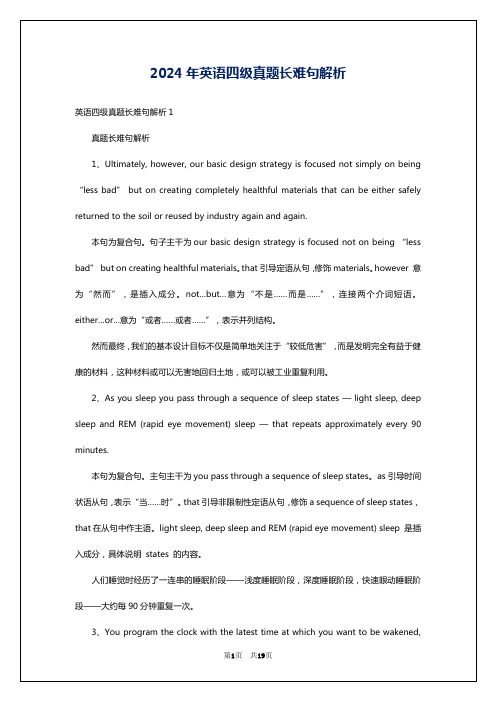
9、Store managers are often the last to hear complaints, and often find out only when their regular customers decide to frequent their competitors, according to a study jointly conducted by Verde Group and Wharton School. (2008年12月)
本句为简单句,主干为This guidance eliminated the need…and avoided confrontation…。eyeing the same parking space为现在分词作后置定语,修饰those。
这些引导消除了顾客在停车场无尽地兜圈子的必要,而且避免了顾客之间因抢占空车位而引发的冲突。
5、We’re giving people high-quality, healthful products and an opportunity to make choices that have a beneficial effect on the world.
本句为复合句。主句为We’re giving people high-quality, healthful products and an opportunity to make choices。that 引导定语从句,修饰 choices,that 在从句中作主语。to make choices 作 opportunity 的定语。
10、“Retailers who’re ponsive and friendly are more likely to smooth over issues than those who aren’t so friendly,” said Professor Stephen Hoch. (2008年12月)
英语四级四级长难句

四级长难句分析在大学英语四级考试的阅读理解中,我们经常会遇到一些长而难的句子。
长难句通常含有较多、较长的修饰成分、并列成分或从句。
长难句的丰富内容和复杂结构往往会导致理解的困难。
理解长难句的关键是了解长难句的类型,理清句子成分,抓住句子中的关键部分。
首先我们先来了解制造长句的几个要点一词汇:核心词汇+普通词汇二语法结构1.从句:定语、同位语、表语、宾语、状语2.并列结构3.插入语4.倒装5.强调6.省略:分词作定语,独立主格结构2008-61.But the real truth is that we don't know enough to relieve global warming, and —— without major technological breakthroughs —— we can't do much about it.2. The trouble with the global warming debate is that it has become a moral problem when it's really an engineering one.3.Privacy economist Alessandro Acauisti has run a series of tests that reveal people w ill surrender personal information like Social Security numbers just to get their hands on a pitiful 50-cents-off coupon(优惠卷)4. The digital bread crumbs(碎屑) you leave everywhere make it easy for strangers to re construct who you are, where you are and what you like.2007-124.The story about a fearful angel starting first grade was quickly “guided” by me into the tale of a little girl with a wild imagination taking her first music lesson.5. Because I know very little about farm animals who use tools or angels who go to first grade, I had to accept the fact that I was co-opting my daughter’s experience.6. While stepping back was difficult for me, it was certainly a good first step that I will quickly follow with more steps, putting myself far enough away to give her room but close enough to help if asked.2007-67. While you need to employ both to get to a finished result, they cannot work in parallel no matter how much we might like to think so.8. Trying to criticize writing on the fly is possibly the single greatest barrier to writing that most of us encounter. If you are listening to that 5th grade English teacher correct your grammar while you are trying to capture a fleeting (稍纵即逝的) thought, the thought will die. If you capture the fleeting thought and simply share it with the world in raw form, no one is likely to understand. You must learn to create first and then criticize if you want to make writing the tool for thinking that it is.9. The practice that can help you past your learned bad habits of trying to edit as you write is what Elbow calls “free writing.”10. As the words begin to flow, the ideas will come from the shadows and let themselves be captured on your notepad or your screen.11. Now you have raw materials that you can begin to work with using the critical mind that you’ve persuaded to sit on the side and watch quietly.12. Most likely, you will believe that this will take more time than you actually have and you will end up staring blankly at the pages as the deadline draws near.13. There was a time in my life when people asked constantly for stories about what it’s like towork in a field dominated by men.14. Sometimes, when I was pushed into an argument on left brain versus (相对于) right brain, or nature versus nurture (培育), I would instantly fight fiercely on my behalf and all womankind.15. Then one day a few years ago, out of my mouth came a sentence that would eventually become my reply to any and all provocations: I don’t talk about that anymore.16. It took me 10 years to get back the confidence I had at 19 and to realize that I didn’t want to deal with gender issues.2006-1217. In fact, New York’s municipal w ater for more than a century was called the champagne of tap water and until recently considered among the best in the world in terms of both taste and purity.18. Similarly, a magazine in England found that tap water from the Thames River tasted better than several leading brands of bottled water that were 400 times more expensive.19. According to an article in The Street Journal, some of the more shameless tactics include placing attractive bottles on the table for a visual sell, listing brands on the menu without prices, and pouring bottled water without even asking the diners if they want it.20. Regardless of how it’s sold, the popularity of bottled water taps into our desire for better health, our wish to appear cultivated, and even a longing for lost purity.21. As we have seen, the focus of medical care in our society has been shifting from curing disease to preventing disease—especially in terms of changing our many unhealthy behaviors, such as poor eating habits, smoking, and failure to exercise.22. Imagine a person who is about the right weight, but does not eat very nutritious foods, who feels OK but exercises only occasionally, who goes to work every day, but is not an outstanding worker, who drinks a few beers at home most nights but does not drive while drunk, and who has no chest pains or abnormal blood counts, but sleeps a lot and often feels tired.23. The field of medicine has not traditionally distinguished between someone who is merely “not ill” and someone who is in excellent health and pays attention to the body’s special needs.24. In recent years, however, some health specialists have begun to apply the terms “well” and “wellness” only to those who are actively striving to maintain and improve their health.25. Even people who have a physical disease or handicap (缺陷) may be “well,” in this new sense, if they make an effort to maintain the best possible health they can in the face of their physical limitations.26. And by focusing attention on healthy ways of living, the concept of wellness can have abeneficial impact on the ways in which people face the challenges of daily life.2006-627. But Hancock says it is also crucial whether a conversation is being recorded and could be reread, and whether it occurs in real time.28. Many immigrants in Salt Lake City were angered by the arrests and said they felt as if they were being treated like disposable goods.▲29. We’re saying we want you to work in these places, we’re going to look the other way in terms of what our laws are, an d then when it’s convenient for us, or when we can try to make a point in terms of national security, especially after Sept. 11, then you’re disposable.30. If Sept. 11 had never happened, the airport workers would not have been arrested and could have gone on quietly living in America, probably indefinitely.2006-6旧31.Women’s education may be unusual territory for economists, but enhancing women’s contribution to development is actually as much an economic as a social issue.32.Parents in low-income countries fail to invest in their daughters because they do not expect them to make an economic contribution to the family: girls grow up only to marry into somebody else’s family and bear children.33.Girls are thus seen as less valuable than boys and art kept at home to do housework while their brothers are sent to school-the prophecy (预言) becomes self-fulfilling, trapping women in a vicious circle of neglect.34.She is likely to have fewer but healthier children and can insist on the development of all her children, ensuring that her daughters are given a fair chance.35.The car is fitted with a remote immobiliser (锁止器), and a radio signal from a control centre miles away will ensure that once the thief switches the engine off, he will not be able to start it again.36.Modern cars are far tougher to steal, as their engine management computer won’t allow them to start unless they receive a unique ID code beamed out by the ignition (点火) key.2005-1237.While here’s on question that continuous stress is ha rmful, several studies suggest that challenging situations in which you’re able to rise to the occasion can be good for you.38.In a 2001 study of 158 hospital nurses, those who faced considerable work demands but coped with the challenge were more likely to say they were in good health than those who felt they get the job done.39. Then there is the general, all covering apology, which avoids the necessity of identifying a specific act that was particularly hurtful or insulting, and which the person who is apologizing should promise never to do again.40. Parents who wish to teach their children to apologize should see it as a sign of strength, and therefore not resort to these pseudo-apologies.实战演练1.But the research paper also gives you a chance to individualize a school assignment, to suit a piece of work to your own interests and abilities, to show others what you can do.2.To determine the consequences of sleep deficit, researchers have put subjects through aset of psychological and performance tests requiring them, for instance, to add columns of numbers or recall a passage read to them only minutes earlier.3.Recent stories in the newspapers and magazines suggest that teaching and researchcontradict each other, that research plays too prominent a part in academic promotions, and that teaching is badly underemphasized.4.House had to be sited “within easy walking distance of the railroad station,” as some oldresidents would point out; and only those wealthy enough to afford a horse and a carriage dared to penetrate farther into the open country.5.White collar workers doing routine work in government offices are, however, as likely tohave shrinking brains as the farm worker, bus driver and shop assistant.6.But you must know that different nations have different ways of looking at things, and youwill therefore not be offended if your ideas of this kind of education happen not to be the same as yours.7.College graduates are selling shoes and driving taxis; college students interfere with eachother’s experiments and write false letters of recommendation in the intense competition for admission to graduate school.8.This means that no sooner has he got used to one routine than he has to change to another,so that much of his time is spent neither working nor sleeping very efficiently.9.The recent growth of export surpluses on the world food market has certainly beenunexpectedly great, partly because a strange sequence of two successful grain harvests.10.It would have amazed the brightest minds of the 18th century Enlightenment (启蒙运动) tobe told by any of us how little we know and how bewildering seems the way ahead.11. All high school graduates ought to go, says conventional wisdom and statistical evidence, because college will help them earn more m oney, become “better” people, and learn to be more responsible citizens than those who don’t go.12. The shops are overstocked with food not only because there is more food available, but also because people, frightened by high prices, are buying less of it.13. Scientists, like other human beings, have their hopes and fears, their passions and disappointments and their strong emotions may sometimes interrupt the course of clear thinking and sound practice.14. Already today, less than forty years later, as computers are relieving us of more and more of the routine tasks in business and in our personal lives, we are faced with a less dramatic but also less foreseen problem.15. This is the research finding of a team of Japanese doctors, who say that most of our brains are not getting enough exercise—and as a result, we are ageing unnecessarily soon.二、总结——长难句分析步骤1、首先确定句子是简单句、复合句或并列句。
四级真题阅读长难句分析-推荐下载

真题阅读长难句分析1. Scott Hahn, cofounder with Gregory of Rogan and Loomstate, which uses all-organic cotton, says high-quality sustainable materials can still be tough to find.2. Most designers with existing labels are finding there aren’t comparable fabrics that can just replace what you’re doing and what your customers are used to,” he says.st year the influential trade show Designers & Agents stopped charging its participation fee for young green entrepreneurs (企业家) who attend its two springtime shows in Los Angeles and New York and gave special recognition to designers whose collections are at least 25% sustainable.4. This week Wal-Mart is set to announce a major initiative aimed at helping cotton farmers go organic: it will buy transitional (过渡型的) cotton at higher prices, thus helping to expand the supply of a key sustainable material.5. Scientists have devised a way to determine roughly where a person has lived using a strand (缕) of hair, a technique that could help track the movements of criminal suspects or unidentified murder victims.6. Todd Park, a local detective, said the method has helped him learn more about an unidentified woman whose skeleton was found near Great Salt Lake.7. He had a perfect résuméand gave good responses to her questions, but the fact that he never looked her in the eye said “untrustworthy,”so she decided to offer the job to her second choice.8. When we begin to question our assumptions and challenge what we think we have learned from our past, from the media, peers, family, friends, etc., we begin to realize that some of our conclusions are flawed (有缺陷的) or contrary to our fundamental values. 9. We need to train ourselves to think differently, shift our mindsets and realize that diversity opens doors for all of us, creating opportunities in organizations and communities that benefit everyone.10. They only come in when a friend drops dead on the golf course and they think, ‘Geez, if it could happen to him, …11.He believes most diseases that commonly affect men could be addressed by preventive check-ups.12. Shoppers seldom complain to the manager or owner of a retail store, but instead will alert their friends, relatives, coworkers, strangers — and anyone who will listen.13. This guidance eliminated the need for customers to circle the parking lot endlessly, and avoided confrontation between those eyeing the same parking space.14.Customers can also improve future shopping experiences by filling complaints to the retailer, instead of complaining to the rest of the world.15. A code of conduct is hard to create when you’re living in a world in which everyone is exhausted from overwork and lack of sleep, and a world in which nice people are perceived to finish last.16. This jumping to our children’s defence is part of what fuels the “walking on eggshells”feeling that surrounds our dealings with other people’s children.17. Assuming you make it to the end of your natural term, about 78 years for men in Australia, you’ll die on average five years before a woman.18. Two months ago Gullotta saw a 50-year-old man who had delayed doing anything about his smoker’s cough for a year.19.Store managers are often the last to hear complaints, and often find out only when their regular customers decide to frequent their competitors, according to a study jointly conducted by Verde Group and Wharton School.20. “Retailers who’re responsive and friendly are more likely to smooth over issues than those who aren’t so friendly,”said Professor Stephen Hoch.21. But the real truth is that we don’t know enough to relieve global warming, and —without major technological breakthroughs — we can’t do much about it.22. We need economic growth unless we condemn the world’s poor to their present poverty and freeze everyone else’s living standards.23. The trouble with the global warming debate is that it has become a moral problem when it’s really an engineering one.24. Whoever it is, they will see you in a way you never intended to be seen —the 21st century equivalent of being caught naked.25. Psychologists tell us boundaries are healthy, that it’s important to reveal yourself to friends, family and lovers in stages, at appropriate times.26. Few people turn down a discount at tollbooths (收费站) to avoid using the EZ-Pass system that can track automobile movements.27. Privacy economist Alessandro Acquisti has run a series of tests that reveal people will surrender personal information like Social Security numbers just to get their hands on a pitiful 50-cents-off coupon (优惠券).28. When you consider that nearly three out of four Americans have seen the game show Who Wants to Be a Millionaire? you can understand the power of television to communicate with a large audience.29.Global warming may or may not be the great environmental crisis of the 21st century, but — regardless of whether it is or isn’t — we won’t do much about it.30. Al Gore calls global warming an “inconvenient truth”, as if merely recognizing it could put us on a path to a solution. 31. The digital bread crumbs(碎屑) you leave everywhere make it easy for strangers to reconstruct who you are, where you are and what you like.32.Only when it’s gone do you wish you’ve done more to protect it.33. But at the same time, the opening of national borders to the flow of goods, services, information and especially people has made universities a powerful force for global integration, mutual understanding and geopolitical stability.34. Objections from American university and business leaders led to improvements in the process and a reversal of the decline, but the United States is still seen by many as unwelcoming to international students.35. In response to the same forces that have driven the world economy, universities have become more self-consciously global: seeking students from around the world who represent the entire range of cultures and values, sending their own students abroad to prepare them for global careers, offering courses of study that address the challenges of an interconnected world and collaborative (合作的) research programs to advance science for the benefit of all humanity.36.Yale professor and Harvard Hughes Medical Institute investigator Tian Xu directs a research center focused on the genetics of human disease at Shanghai’s Fudan University in collaboration with faculty colleagues from both schools.37. In the wake of September 11, changes in the visa process caused a dramatic decline in the number of foreign students seeking admission to U.S. universities, and a corresponding surge in enrollments in Australia, Singapore and the U.K.38. While the kinds of instruction offered in these programs will differ, DL usually signifies a course in which the instructors post syllabi (课程大纲), reading assignments, and schedules on Websites, and students send in their assignments by e-mail 39.Telling myself that I was merely an experienced writer guiding the young writer across the hall, I offered suggestions for characters, conflicts and endings for her tales.40. While stepping back was difficult for me, it was certainly a good first step that I will quickly follow with more steps, putting myself far enough away to give her room but close enough to help if asked.41. Not only do we evaluate the cause of the pain, which canhelp us treat the pain better, but we also help provide comprehensive therapy for depression and other psychological and social issues related to chronic pain.42. Then one day a few years ago, out of my mouth came a sentence that would eventually become my reply to any and all provocations: I don’t talk about that anymore.43. The practice that can help you past your learned bad habits of trying to edit as you write is what Elbow calls “free writing.”44. While you need to employ both to get to a finished result, they cannot work in parallel no matter how much we might like to think so.45. Unlike physical energy, which is limited and diminishes with age, emotional energy is unlimited and has nothing to do with genes or upbringings.46. “Wellness”may perhaps best be viewed not as a state that people can achieve, but as an ideal that people can strive for.47. If you are listening to that 5th grade English teacher correct your grammar while you are trying to capture a fleeting (稍纵即逝的) thought, the thought will die.48. Regardless of how it’s sold, the popularity of bottled water taps into our desire for better health, our wish to appear cultivated, and even a longing for lost purity.49. According to an article in The Wall Street Journal, some of the more shameless tactics include placing attractive bottles on the table for a visual sell, listing brands on the menu without prices, and pouring bottled water without even asking the diners if they want it.50. Built with safety in mind, the highways have wide lanes and shoulders, dividing medians or barriers, long entry and exit lanes, curves engineered for safe turns, and limited access.51. But since water is much cheaper than wine, and many of the fancier brands aren’t available in stores, most diners don’t notice or care.52. He must use the sounds of speech to identify the words spoken, understand the pattern of organization of the words (sentences), and finally interpret the meaning. 53. Perhaps it was the extreme contrast with Japanese society that prompted American firms to pay more attention to women buyers.54. As we have seen, the focus of medical care in our society has been shifting from curing disease to preventing disease —especially in terms of changing our many unhealthy behaviors, such as poor eating habits, smoking and failure to exercise. 55. Reaching new peaks of popularity in North America is Iceberg Water, which is harvested from icebergs off the coast of Newfoundland, Canada.56. Ultimately, however, our basic design strategy is focused not simply on being “less bad”but on creating completely healthful materials that can be either safely returned to the soil or reused by industry again and again.57. As you sleep you pass through a sequence of sleep states —light sleep, deep sleep and REM (rapid eye movement) sleep —that repeats approximately every 90 minutes.58.You program the clock with the latest time at which you want to be wakened, and it then duly(适时地) wakes you during the last light sleep phase before that.59. Home builders can now use materials — such as paints that release significantly reduced amounts of organic compounds —that don’t destroy the quality of the air, water, or soil.60. We’re giving people high-quality, healthful products and an opportunity to make choices that have a beneficial effect on the world.61. When we designed America’s first so-called “green”office building in New York two decades ago, we felt very alone.62. The “energy-efficient”sealed commercial buildings constructed after the 1970s energy crisis revealed indoor air quality problems caused by materials such as paint, wall covering and carpet.63. So for 20 years, we’ve been focusing on these materials down to the molecules, looking for ways to make them safe for people and the planet.64. “As sleep-deprived people ourselves, we started thinking of what to do about it,” says Eric Shashoua, a recent collegegraduate and now chief executive officer of Axon Sleep Research Laboratories, a company created by the students to develop their idea.65. The headband equipped with electrodes and microprocessor measures the electrical activity of the wearer’s brain, in much the same way as some machines used for medical and research purposes and communicates wirelessly with a clock unit near the bed.66. Interest in pursuing international careers has soared in recent years, enhanced by chronic(长久的) personnel shortages that are causing companies to search beyond their home borders for talent.67. Variables included the slope of the land, the ability of the pavement to support the load, the intensity of road use and the nature of the underlying soil.68. Long-span, segmented-concrete, cable-stayed bridges such as Hale Boggs in Louisiana and the Sunshine Skyway in Florida, and remarkable tunnels like Fort McHenry in Maryland and Mt. Baker in Washington, met many of the nation’s physical challenges.69. Not only has the highway system affected the American economy by providing shipping routes, it has led to the growth of spin-off industries like service stations, motels, restaurants, and shopping centers.70. An educated mother, on the other hand, has greater earning abilities outside the home and faces an entirely different set of choices.71. His results, to be presented at the conference on human-computer interaction in Vienna, Austria, in April, have surprised psychologists.72. And economics, with its emphasis on incentives,provides guideposts that point to an explanation for why so many girls are deprived of an education.73. Many in-home jobs that used to be done primarily by women — ranging from family shopping to preparing meals to doing voluntary work — still need to be done by someone.74. In fact, New York’s municipal water for more than a century was called the champagne of tap water and until recently considered among the best in the world in terms of both taste and purity.75. Girls are thus seen as less valuable than boys and are kept at home to do housework while their brothers are sent to school —the prophecy(预言) becomes self-fulfilling, trapping women in a vicious circle(恶性循环) of neglect.76. It starts in the Pacific Ocean and is thought to be caused bya failure in the trade winds(信风), which affects the ocean currents driven by these winds.77. A government study recommended a national highway system of 33,920 miles, and Congress soon passed the Federal-Aid Highway Act of 1944, which called strict, centrally controlled design criteria.78. Traffic control systems and methods of construction developed under the interstate program soon influenced highway construction around the world, and were invaluable in improving the condition of urban streets and traffic patterns.79. By opening the North American continent, highways have enabled consumer goods and services to reach people in remote and rural areas of the country, spurred the growth of suburbs, and provided people with greater options in terms of jobs, access to cultural programs, health care, and other benefits.80. The technological advances made it possible for the middle classes to enjoy what had once been affordable only to the very rich.81. The clock, called Sleep Smart, measures your sleep cycle, and waits for you to be in your lightest phase of sleep before rousing you.82. The point in that sleep cycle at which you wake can affect how you feel later, and may even have a greater impact than how much or little you have slept.83. While she awaits the outcome, the government has granted her permission to work here and she has returned to her job at Ben&Jerry’s.84. Modern cars are far tougher to steal, as their engine management computer won’t allow them to start unless they receives a unique ID code beamed out by the ignition(点火) key.85. The first study to compare honesty across a range of communications media has found that people are twice as likely to tell lies in phone conversations as they are in emails. 86. As the trade winds lessen in strength, the ocean temperatures rise, causing the Peru current flowing in from theeast to warm up by as much as 5℃.87. The interstate highway system was finally launched in 1956 and has been hailed as one of the greatest public works projects of the century.88. He says it would only take him a few minutes to teach a person how to steal a car, using a bare minimum of tools.89. But Hancock says it is also crucial whether a conversation is being recorded and could be reread, and whether it occurs in real time.90. If you are submitting your resume in English, find out if the recipient(收件人) uses British English or American English because there are variations between the two versions.91. I wondered what I would do if confronted with a real midair medical emergency without access to a hospital staff and the usual emergency equipment.92. Thanks to more recent legislation, flights with at least one attendant are starting to install emergency medical kits to treat heart attacks.93. The logo, along with the company’s long-held marketing image of the “irresistibility” of its chips, would help facilitate the company’s global expansion.94. The executives acknowledge that they try to swing national eating habits to a food created in America, but they deny that amounts to economic imperialism.95. While there’s no question that continuous stress is harmful, several studies suggest that challenging situations in which you’re able to rise to the occasion can be good for you. 思考类动词总结Think/assume/conceive/conclude/expect/determine/hold/judge/presume/reckon/see/sense/suppose/comprehend/consider/deduceinfer/deliberate/evaluate/examine/meditate/mull/mull over/muse/ponder/rationalize/reason/reflect/resolve/ruminate/speculate/study/turn over/weigh/contemplate/convey重要的;显著的important/valuable/substantial/big/considerable/critical/crucial/decisive/earnest/exceptional/markedmeaningful/momentous/paramount/salient/significant/weightyeminent/influential/outstanding/distinctive/esteemed/grandhonored/illustrious/leading/majestic/notable/powerfulprominent/remarkable/solid/superior/conspicuous 增加/发展increase/develop/enlarge/expand/grow/raiseadvance/aggrandize/amplify/augment/boost/broaden/enhance/enlarge/escalate/extendfurther/heighten/inflate/magnify/mountprogress/proliferate/spread/swell/widen96. As a physician who travels quite a lot, I spend a lot of time on planes listening for that dreaded “Is there a doctor on board?” announcement. (2005年12月)【分析】本句为复合句。
大学英语四级阅读真题长难句型分析
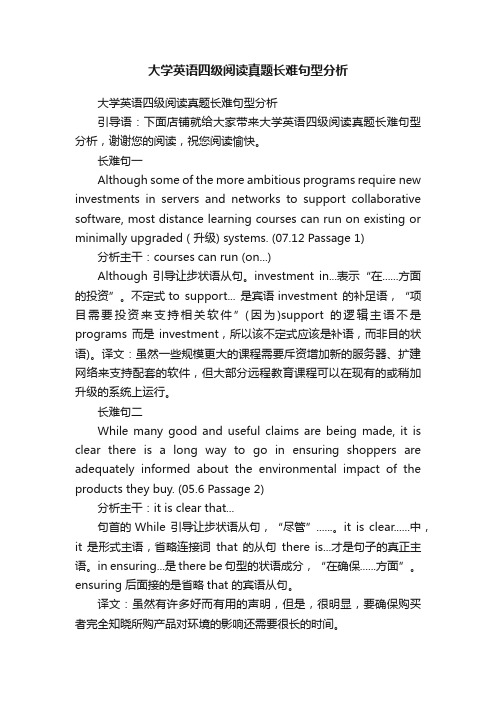
大学英语四级阅读真题长难句型分析大学英语四级阅读真题长难句型分析引导语:下面店铺就给大家带来大学英语四级阅读真题长难句型分析,谢谢您的阅读,祝您阅读愉快。
长难句一Although some of the more ambitious programs require new investments in servers and networks to support collaborative software, most distance learning courses can run on existing or minimally upgraded ( 升级) systems. (07.12 Passage 1) 分析主干:courses can run (on...)Although 引导让步状语从句。
investment in...表示“在......方面的投资”。
不定式to support... 是宾语investment 的补足语,“项目需要投资来支持相关软件”(因为)support 的逻辑主语不是programs 而是investment,所以该不定式应该是补语,而非目的状语)。
译文:虽然一些规模更大的课程需要斥资增加新的服务器、扩建网络来支持配套的软件,但大部分远程教育课程可以在现有的或稍加升级的系统上运行。
长难句二While many good and useful claims are being made, it is clear there is a long way to go in ensuring shoppers are adequately informed about the environmental impact of the products they buy. (05.6 Passage 2)分析主干:it is clear that...句首的While 引导让步状语从句,“尽管”......。
英语四级阅读长难句句子结构分析
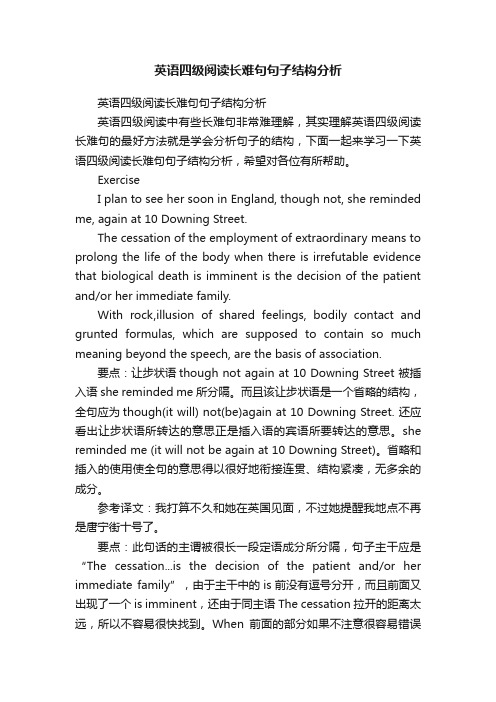
英语四级阅读长难句句子结构分析英语四级阅读长难句句子结构分析英语四级阅读中有些长难句非常难理解,其实理解英语四级阅读长难句的最好方法就是学会分析句子的结构,下面一起来学习一下英语四级阅读长难句句子结构分析,希望对各位有所帮助。
ExerciseI plan to see her soon in England, though not, she reminded me, again at 10 Downing Street.The cessation of the employment of extraordinary means to prolong the life of the body when there is irrefutable evidence that biological death is imminent is the decision of the patient and/or her immediate family.With rock,illusion of shared feelings, bodily contact and grunted formulas, which are supposed to contain so much meaning beyond the speech, are the basis of association.要点:让步状语though not again at 10 Downing Street 被插入语she reminded me所分隔。
而且该让步状语是一个省略的结构,全句应为though(it will) not(be)again at 10 Downing Street. 还应看出让步状语所转达的意思正是插入语的宾语所要转达的意思。
she reminded me (it will not be again at 10 Downing Street)。
四级阅读长难句分析

定语 1.定语是用来修饰名词;代词或句子的成分. 2. 定语有前置定语,后置定语. 3. 充当定语的词有:形容词;名词;代词;数词; 名词所有格......方位副词;不定式;动词的- ing形式;过去分词;从句等.例如: Tom is a handsome boy. (形容词作定语 ) His name is Tom. (代词作定语) The boy in blue is Tom. (介词短语作定语) There is nothing to do today(不定式作定语 )
宾语补足语:位于宾语之后对宾语作出说明的成分。宾 语与其补足语有逻辑上的主谓关系,它们一起构成复 合宾语。 1. 名词/代词宾格 + 名词: The war made him a soldier. 2. 名词/代词宾格 + 形容词: Please keep the room clean. 3. 名词/代词宾格 + 介词短语: I often find him at work. 4. 名词/代词宾格 + 动词不定式: The teacher ask the students to close the windows. 5. 名词/代词宾格 + 分词: I saw a cat running across the road.
2. 句子成分
1. 组成句子的成分叫句子成分。 1. 2. 组成句子的成分叫句子成分。 在句子中,词与词之间有一定的组合关系, 2. 按照不同的关系,可以把句子分为不同的 在句子中,词与词之间有一定的组合关 系,按照不同的关系,可以把句子分为不 组成成分。 同的组成成分。 3. 句子成分由词或词组充当。 3. 句子成分由词或词组充当。 4. 英语句子的基本成分有六种:主语 4. 英语的基本成分有六种:主语(subject)、 ( subject )、谓语( predicate )、表语 谓语(predicate)、表语(predicative)、 ( predicative )、宾语( object)、定语 宾语( object)、定语( attribute )和状语 ( attribute )和状语(adverbial)。 (adverbial) 。
大学英语四级阅读理解长难句

四级阅读长难句分析1. A survey found an overwhelming pessimism about privacy, with 60 percent of respondents saying they feel their privacy is “slipping away, and that bothers me.” 分析主干:A survey found an (overwhelming) pessimism... 句中with 引导的介词短语作状语,其后带了复合宾语(即宾语+补语)。
该复合宾语用现在分词saying 作补语,saying 还带了一个宾语从句they feel...,而feel 也带有宾语从句,由and 连接两个分句their privacy is slipping away 和that bothers me 构成。
译文:一次调查发现人们对于隐私普遍持悲观态度,60%的受访者说他们觉得隐私正在“离自己远去,而这让我很忧心。
”2. Global warming may or may not be the great environmental crisis of the 21st century, but—regardless of whether it is or isn‘t—we won’t do much about it. 分析主干:Global warming may or may not be the crisis... but we won‘t do much... 句子主干是个并列句,由but 连接的两个分句之间是转折关系。
前一个分句用了复合谓语,是肯定形式和否定形式并列的结构,利用了情态动词来省略。
后一个分句包含一个复杂介词regardless of 引导的短语,表示“不管”,of 后面接一个whether 引导的宾语从句。
译文:全球变暖有可能是21 世纪巨大的环境危机,也有可能不是,但是—无论它是或不是—我们都对此无能为力。
英语四级阅读长难句结构技巧分析
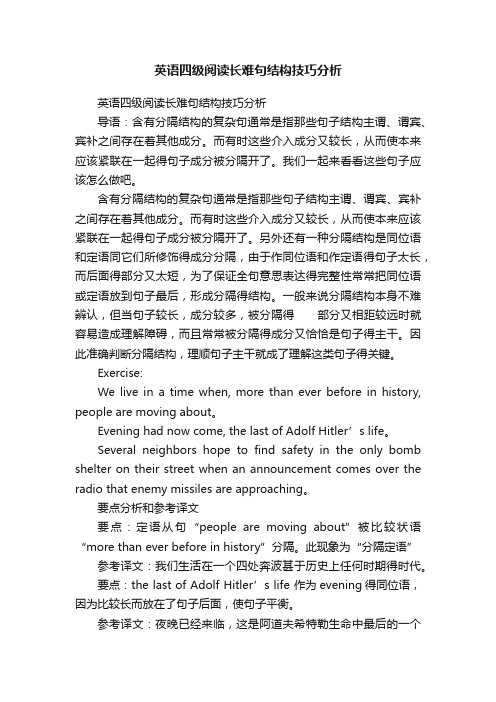
英语四级阅读长难句结构技巧分析英语四级阅读长难句结构技巧分析导语:含有分隔结构的复杂句通常是指那些句子结构主谓、谓宾、宾补之间存在着其他成分。
而有时这些介入成分又较长,从而使本来应该紧联在一起得句子成分被分隔开了。
我们一起来看看这些句子应该怎么做吧。
含有分隔结构的复杂句通常是指那些句子结构主谓、谓宾、宾补之间存在着其他成分。
而有时这些介入成分又较长,从而使本来应该紧联在一起得句子成分被分隔开了。
另外还有一种分隔结构是同位语和定语同它们所修饰得成分分隔,由于作同位语和作定语得句子太长,而后面得部分又太短,为了保证全句意思表达得完整性常常把同位语或定语放到句子最后,形成分隔得结构。
一般来说分隔结构本身不难辨认,但当句子较长,成分较多,被分隔得部分又相距较远时就容易造成理解障碍,而且常常被分隔得成分又恰恰是句子得主干。
因此准确判断分隔结构,理顺句子主干就成了理解这类句子得关键。
Exercise:We live in a time when, more than ever before in history, people are moving about。
Evening had now come, the last of Adolf Hitler’s life。
Several neighbors hope to find safety in the only bomb shelter on their street when an announcement comes over the radio that enemy missiles are approaching。
要点分析和参考译文要点:定语从句“people are moving about”被比较状语“more than ever before in history”分隔。
此现象为“分隔定语”参考译文:我们生活在一个四处奔波甚于历史上任何时期得时代。
四级阅读长难句

长难句特点:
1、 主语或宾语拉长 2、分词短语打头 3、多个谓语动词连用
பைடு நூலகம்
总原则:浓缩主干,找出核心句型 五大句型
4、举例作为插入语
5、并列句连用使得句子变长
6、多重复合句叠加
1、 主语或宾语拉长 解决方法:有效分解主谓成分,断
开之后各个击破。
T—h—e——s—tr—e—a—m——s,—l—a—k—e—s—, —m—e—a—d—o—w——s—(草——地——)— , mountain ridges and forests that make
解决方法:理清主动和被动关系。一般来说现在分词与主 语之间是主动关系;而过去分词与主语之间是被动关系。
Operating out of a century-old schoolhouse in the
vBiulldagCeooofkL(o大ng自P然on保d,护Pe协nn会sy)lvisanwiao,r—kthi—ne—gC—wo—nit—she—rlov—ca—anl—cy—’s
————————————————————————
the Pocono an ideal place for black bears have also attracted more people
——————————————— ——————————
to the region. (2005.6)
溪流、湖泊、草地、山脉、森林,这些不仅使得Pocono 成为黑熊理想的栖息地,而且吸引了越来越多人来到这里。
• 4、举例作为插入语
提示词such as; for example; including etc.
of high academic achievement and economic success, for possible answers.(2005.1)
英语四级阅读真题长难句型分析

英语四级阅读真题长难句型分析英语四级阅读真题长难句型分析引导语:应届毕业生培训网整理精选了一些大学英语四级阅读真题长难句型分析,希望能够帮助到您,谢谢您的阅读。
句型一The I SO labeling standards ban vague or misleading claims on product packaging, because terms such as “environmentally friendly”and “non-polluting”cannot be verified. (05.6 Passage 2)分析主干:院The standards ban claims本句只含一个原因状语从句,结构上较为简单。
值得注意的是,句中的名词词组大多含有修饰成分,如:The ISO labeling standards, claims on product packaging, terms such as...。
译文:ISO 标识标准禁止在商品的包装上出现模糊的或会引起误导的产品说明,因为我们无法证明类似“环保”、“无污染”等这样的字样。
句型二While the kinds of instruction offered in these programs will differ, distance learning usually signifies a course in which the instructors post syllabi (课程大纲), reading assignments, and schedules on Websites, and students send in their assignments by e-mail. (07.12 Passage 1)分析主干:distance learning signifies a course1.句首While 引导状语从句,有让步、对比之意。
英语四级真题阅读长难句分析
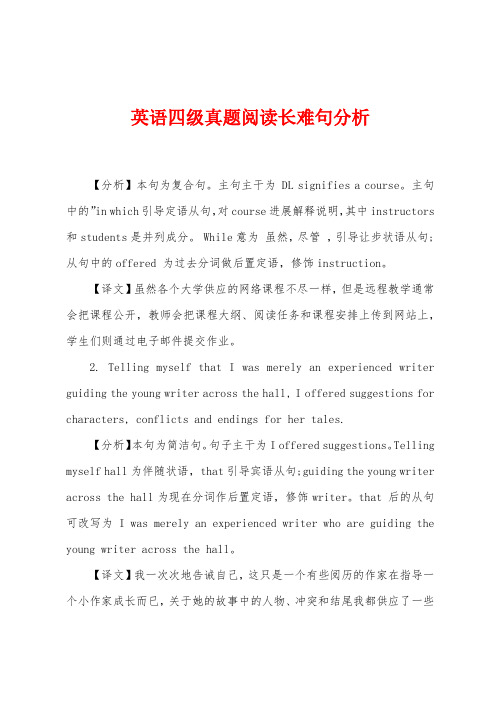
英语四级真题阅读长难句分析
【分析】本句为复合句。
主句主干为 DL signifies a course。
主句中的”in which引导定语从句,对course进展解释说明,其中instructors 和students是并列成分。
While意为虽然,尽管,引导让步状语从句;从句中的offered 为过去分词做后置定语,修饰instruction。
【译文】虽然各个大学供应的网络课程不尽一样,但是远程教学通常会把课程公开,教师会把课程大纲、阅读任务和课程安排上传到网站上,学生们则通过电子邮件提交作业。
2. Telling myself that I was merely an experienced writer guiding the young writer across the hall, I offered suggestions for characters, conflicts and endings for her tales.
【分析】本句为简洁句。
句子主干为I offered suggestions。
Telling myself hall为伴随状语,that引导宾语从句;guiding the young writer across the hall为现在分词作后置定语,修饰writer。
that 后的从句可改写为I was merely an experienced writer who are guiding the young writer across the hall。
【译文】我一次次地告诫自己,这只是一个有些阅历的作家在指导一个小作家成长而已,关于她的故事中的人物、冲突和结尾我都供应了一些
建议。
(全)大学英语四级真题,阅读理解长难句解析+翻译

大学英语四级真题,阅读理解长难句解析+翻译大学英语四级真题,阅读理解长难句,逐句解析。
Professor Ashok Goel of Georgia Tech developed an artificially intelligent teaching assistant to help handle the enormous number of student questions in the online class, Knowledge Based Artificial Intelligence.乔治亚理工大学的Ashok Goel教授研发人工智能助教,以回答网课Knowledge Based Artificial Intelligence上学生大量的问题。
大学英语四级长难句解析本句词法:help后出现了省略to的动词原形。
句法:本句只有主语,谓语,宾语,但是to help 后出现了动宾结构作宾语,其后,又有状语,故而将句子长度增加。
语义提取:注意,课程名称不必重新占用句子成分。
逻辑推理:本句位于文章之首,并非观点,而是描述事实,所以本文题材可以确定是说明文。
四级中说明文一般与解决问题相结合,提出问题,解决方法,是这类题目的重点。
本句,作用是交代背景。
This online course is a core requirement of Georgia Tech's online Master of Science in Computer Science program.在计算机科学课程中,这个网课是在线理科研究生的核心必修课。
2019年12月大学四级真题本句词法:of前面是名词,后面也是名词,整个是一个成分,虽然距离很长,但是作用简单。
句法:本句是简单句,只有主语谓语宾语。
语义提取:汉语状语前置。
逻辑推理:交代背景细节。
说明此课程的重要性。
Professor Goel already had 8 teaching assistants, but that wasn't enough to deal with the overwhelming number of questions from students. Goel教授已经有8个助教,但是不足以回复学生提出的大量问题。
英语四级阅读长难句结构的分析

英语四级阅读长难句结构的分析英语四级阅读长难句结构的分析1. It took me 10 years to get back the confidence I had at 19 and to realize that I didnt want to deal with gender issues.分析主干:It took me 10 years to get back... and to realize...句首的 It 是形式主语,真正的主语是 and 并列的两个动词不定式。
第一个不定式to get back 的宾语 the confidence 后有一个定语从句I had at 19 对它加以修饰。
第二个不定式 to realize 带了一个宾语从句,由 that 引导。
译文我花了 10 年的时间才找回了我 19 岁时的自信,才意识到我本不想谈论性别问题。
2. If you are listening to that 5th grade English teacher correct your grammar while you are trying to capture a fleeting thought, the thought will die.分析主干:the thought will die本句的难点在从句部分。
If 引导条件状语从句,从句用了listen to sb. do sth.结构,省略to 的不定式correct 作补语曰that 5th grade English teacher 用了借喻的修辞手法,指代你心中的那个批判性思维。
while 引导的'时间状语从句修饰 are listening。
译文如果你在听五年级的英文老师纠正你的语法,而同时你又尽力在捕捉一个稍纵即逝的想法,那么,你的想法就会消失得无影无踪。
3. Store managers are often the last to hear complaints, and often find out only when their regular customers decide to frequent their competitors, according to a study jointly conducted by Verde Group and Wharton School.。
四级长难句分析
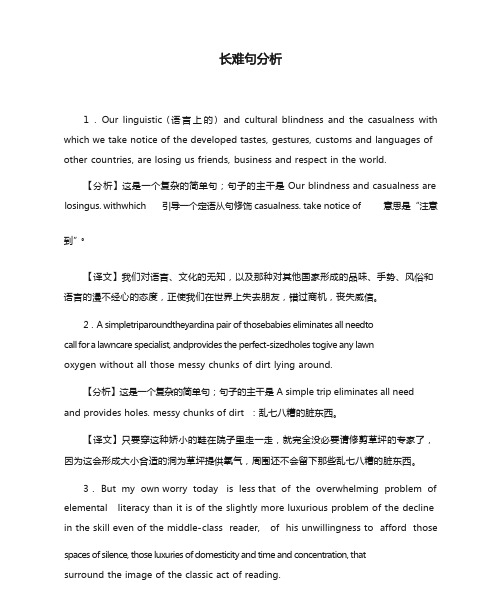
1.Our linguistic (语言上的)and cultural blindness and the casualness with which we take notice of the developed tastes, gestures, customs and languages of other countries, are losing us friends, business and respect in the world.【分析】这是一个复杂的简单句;句子的主干是 Our blindness and casualness are losingus. withwhich 引导一个定语从句修饰 casualness. take notice of 意思是“注意。
到”【译文】我们对语言、文化的无知,以及那种对其他国家形成的品味、手势、风俗和语言的漫不经心的态度,正使我们在世界上失去朋友,错过商机,丧失威信。
2.A simpletriparoundtheyardina pair of thosebabies eliminates all needtocall for a lawncare specialist, andprovides the perfect-sizedholes togive any lawnoxygen without all those messy chunks of dirt lying around.【分析】这是一个复杂的简单句;句子的主干是 A simple trip eliminates all need and provides holes. messy chunks of dirt :乱七八糟的脏东西。
【译文】只要穿这种娇小的鞋在院子里走一走,就完全没必要请修剪草坪的专家了,因为这会形成大小合适的洞为草坪提供氧气,周围还不会留下那些乱七八糟的脏东西。
英语四级真题阅读长难句分析
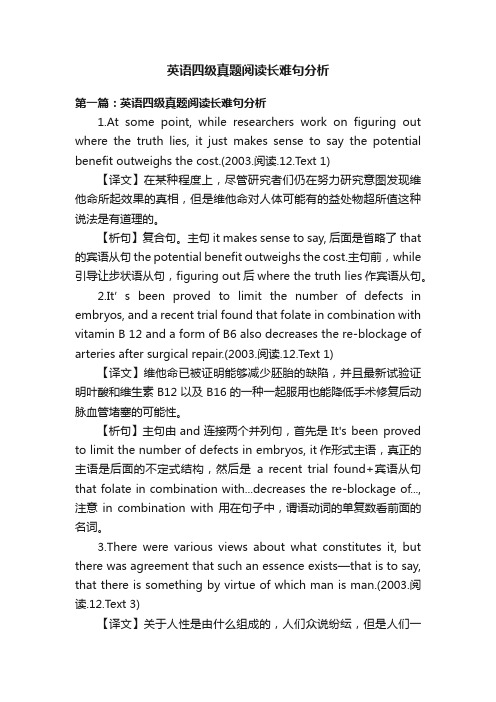
英语四级真题阅读长难句分析第一篇:英语四级真题阅读长难句分析1.At some point, while researchers work on figuring out where the truth lies, it just makes sense to say the potential benefit outweighs the cost.(2003.阅读.12.Text 1)【译文】在某种程度上,尽管研究者们仍在努力研究意图发现维他命所起效果的真相,但是维他命对人体可能有的益处物超所值这种说法是有道理的。
【析句】复合句。
主句it makes sense to say, 后面是省略了that 的宾语从句the potential benefit outweighs the cost.主句前,while 引导让步状语从句,figuring out后where the truth lies作宾语从句。
2.It’s been proved to limit the number of defects in embryos, and a recent trial found that folate in combination with vitamin B 12 and a form of B6 also decreases the re-blockage of arteries after surgical repair.(2003.阅读.12.Text 1)【译文】维他命已被证明能够减少胚胎的缺陷,并且最新试验证明叶酸和维生素B12以及B16的一种一起服用也能降低手术修复后动脉血管堵塞的可能性。
【析句】主句由and连接两个并列句,首先是It's been proved to limit the number of defects in embryos, it作形式主语,真正的主语是后面的不定式结构,然后是a recent trial found+宾语从句that folate in combination with...decreases the re-blockage of..., 注意in combination with用在句子中,谓语动词的单复数看前面的名词。
四级真题英语阅读长难句分析

四级真题英语阅读长难句分析四级真题英语阅读长难句分析1. Recent decisions by Hamilton and others may be “a sign that people are starting to realize that there’s this destructive competition going on,” says Baum, co-author of a recent College Report that raises concerns about the role of institutional aid not based on need. (2009. 阅读. Text A)【译文】鲍姆认为,哈密顿和其他人最近的决定可能就是“一种迹象表明人们开始意识到存在一种破坏性竞争”。
他是最近一项大学调查报告的组织者之一,这项报告引发了人们对并非基于需要的制度性经济援助的关心。
【析句】复合句。
主干是Baum says+宾语从句,也就是Baum 说话的内容。
宾语从句的主句是Recent decisions may be "a sign that are starting to realize that there is this destructive competition...", 引号内包含两个从句,that引导定语从句修饰a sign, realize后是that引导的宾语从句。
最后,co-author of a recent College Report作Baum的同位语,that raises concerns about...是College Report的定语从句。
2. “No one can take one-sided action,” says Laird, who is exploring whether to seek an exemption from federal anti-trust laws so member colleges can discuss how they could jointly reduce merit aid. (2009. 阅读. Text A)【译文】"任何人都不能采取单方面的行动。
- 1、下载文档前请自行甄别文档内容的完整性,平台不提供额外的编辑、内容补充、找答案等附加服务。
- 2、"仅部分预览"的文档,不可在线预览部分如存在完整性等问题,可反馈申请退款(可完整预览的文档不适用该条件!)。
- 3、如文档侵犯您的权益,请联系客服反馈,我们会尽快为您处理(人工客服工作时间:9:00-18:30)。
4.主语+及物动词+双宾语(间接宾语指人,直接宾语指 物)(A gives B something.) My visit to IBM, AT&T and the Bell laboratory yesterday gave me some first-hand knowledge of the latest successes in modern science and technology. 昨天,我参观了国际商用机器公司、美国电话电报公司和 贝尔实验室,领略了当代科技发展的前沿成就。 5.主语+及物动词+复合宾语(即宾语+宾语补足语) (A tells B to do something) Today, the Chinese people who are struggling to achieve modernization have made the opening-up a basic state policy. 今天,正在为实现现代化而奋斗的中国人民,把对外开放 作为一项基本国策。 6.There+系动词+主语(There is a man.) There are many types of businesses in a free-market economy. 在自由市场经济国家企业类型有多种多样。
状语: 状语修饰动词、形容词、副词或全句,说明方式、因 果、条件、时间、地点、让步、方向、程度、目的 等。用作状语的通常是副词。 1)副词(短语)作状语: The boy needs a pen very much.(程度状语) The boy , now , needs a pen.(时间状语) 2)介词短语作状语: In the classroom, the boy needs a pen.(地点状语) Before his mother, Tom is always a boy.(条件状语) On Sundays, there is no student in the classroom.(时 间状语) 3)不定式作状语: The boy needs a pen to do his homework.(目的状语) 4)名词作状语: Come this way! (方向状语)
四级阅读长难句分析
1、句子种类和类型
(一)按使用目的,句子可分为陈述句、疑问句、祈使句和感叹句。 1)陈述句(Declarative Sentences/Statement):说明一个事实或陈述一种 看法。例如: Light travels faster than sound. (说明事实) The film is rather boring. (说明看法) 2)疑问句(Interrogative Sentences/Question):提出问题。有以下四种: a. 一般疑问句(General Questions): Can you finish the work in time? b. 特殊疑问句(Wh-Questions): Where do you live? c. 选择疑问句(Alternative Questions): Do you want tea or coffee? d. 反意疑问句(Tag-Questions): He doesn't know her, does he? 3)祈使句(Imperative Sentences/Command):提出请求,建议或发出命 令。例如: Don't be nervous! 别紧张! 4)感叹句(Exclamatory Sentences/Exclamation):表示说话人惊奇、喜 悦、愤怒等情绪。例如: What good news it is! 多好的消息啊!
(二)句子按其结构可以分为以下三类: 1)简单句(Simple Sentences):只包含一个主谓结 构句子叫简单句。例如: She is fond of collecting stamps. 2)并列句(Compound Sentences):包含两个或两 个以上主谓结构的句子叫并列句,句与句之间通常用 并列连词或分号来连接。例如: The food was good, but he had little appetite. 3)复合句(Complex Sentences):包含一个主句和 一个或几个从句的句子叫复合句,从句由从属连词引 导。例如: The film had begun when we got to the cinema.
同位语 the Appositive
同位语是句子成分的一种, 它位于名词、代词后面, 说明它们的性质 和情况, 它可以由名词、代词、名词性短语或从句充当。同位语的
表现 monitor, is a handsome boy. (2) 代词: I myself will do the experiment. (3) 数词: She is the oldest among them six. (4) 从句: He told me the news that the plane had exploded. (5) 由such as, that is引导 Some subjects, such as maths and physics, are very difficult to learn. (6) 由 of 引导 The city of Beijing has been greatly changed since 2000. (7) 由 or 引导 The freezing temperature, or freezing point, is the temperature at which water freezes under ordinary pressure.
表语 1. 表语是表述主语的特征、状态或身份等。 2. 表语位于连系动词之后,二者构成系表结 构,即合成谓语 3. 表语由名词、形容词或相当于名词或形容 词的词、短语或句子等充当。 • Her brother is a driver.(名词) • Are you ready?(形容词) • We were at home last night.(介词短语) • This book is mine, not yours.(代词) • The film is exciting.(现在分词)
句子成分
主语 1. 主语是一个句子的主题,也是句子的主 体,表示句子主要说明的人或事物。 2. 它的位置一般在句首。 3. 一般由名词、代词或相当于名词或代词的 词、短语或句子等充当。 The meeting will begin at 9:00.(名词) We study in No. 1 Middle School.(代词) Smoking is bad for you.(动名词)
4、并列句
并列句: 用并列连接词把两个或两个以上的简单句 连接在一起的句子叫并列句. 常用的连接词如下: also, and, but, either ... or, however, not only...but also, or, or else(否则,要 不然), so, still(仍然;但是;尽管如此 ), yet, neither...nor. 并列句的构成: 简单句 + 连接词 + 简单句。 1. He studied hard and he passed the examination. 2. Let„s hurry, or we‟ll be late. 3. I have been to Beijing many times but my parents have never been there.
3、简单句6种基本结构。
1.主语+系动词+表语(A is B.) Harvard is among the first American universities to accept Chinese students. 哈佛是最早接受中国留学生的美国大学之一。 2.主语+及物动词+宾语(A does B.) These traditions have exerted a profound impact on the values and way of life of the Chinese people, and on China‟s road of development today. 这些传统,对今天中国人的价值观念、生活方式和中国的 发展道路,具有深刻的影响。 3.主语+不及物动词(A leaves.) In 1847, Chinese student Rong Hong and others came to the United States as the first group of Chinese students to study here. 1847年,中国最早的一批留美学生容闳等人赴美求学。
定语 1.定语是用来修饰名词;代词或句子的成分. 2. 定语有前置定语,后置定语. 3. 充当定语的词有:形容词;名词;代词;数词; 名词所有格......方位副词;不定式;动词的- ing形式;过去分词;从句等.例如: Tom is a handsome boy. (形容词作定语 ) His name is Tom. (代词作定语) The boy in blue is Tom. (介词短语作定语) There is nothing to do today(不定式作定语 )
宾语 1.宾语表示动作、行为的对象。 2.只有及物动词可带宾语,有些不及物动词加上介 词或副词也可带宾语。 3.由名词、代词或相当于名词的词、短语或句子担 当。 • He often helps me.(代词) • We study English at school.(名词) • If you add 5 to 5, you get 10.(数词) • Remember to buy some stamps.(动词不定式) • He likes making you laugh.(动名词) • He said, "You are wrong."(句子) • Do you understand what I mean?(从句)
